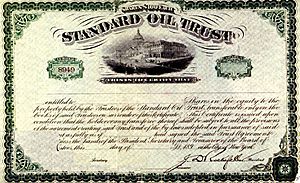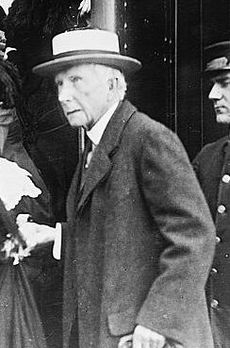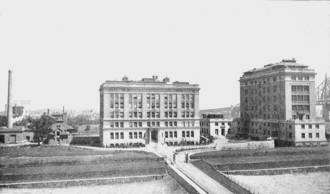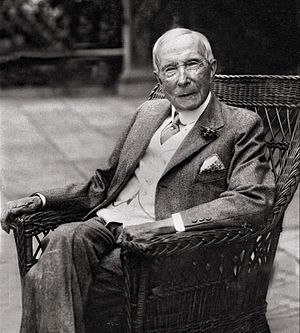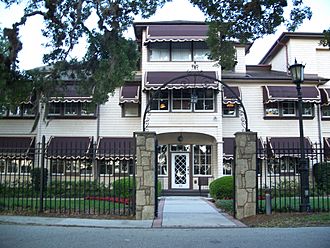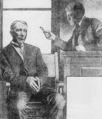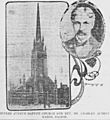John D. Rockefeller facts for kids
Quick facts for kids
John D. Rockefeller
|
|
|---|---|
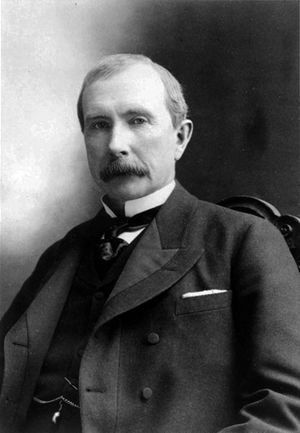
John D. Rockefeller in 1885
|
|
| Born |
John Davison Rockefeller
July 8, 1839 Richford, New York, U.S.
|
| Died | May 23, 1937 (aged 97) The Casements
Ormond Beach, Florida, U.S. |
| Burial place | Lake View Cemetery, Cleveland, Ohio, U.S. 41°30′40″N 81°35′28″W / 41.511°N 81.591°W |
| Occupation | Oil industry business magnate and philanthropist |
| Known for | Founding and leading the Standard Oil Company
Founding the University of Chicago, Rockefeller University, Central Philippine University, General Education Board and Rockefeller Foundation |
| Net worth | US$478 billion (in 2022 dollars; inflation-adjusted) in 1913, according to Forbes (1.5% to 2% of the United States economy; or approximately 1/65th to 1/50th of its GDP) |
| Political party | Republican |
| Spouse(s) | Laura Celestia Spelman (m. 1864–1915; her death) |
| Children | Elizabeth, Alice, Alta, Edith, and John Jr. |
| Parent(s) |
|
| Relatives | Rockefeller family |
John Davison Rockefeller (July 8, 1839 - May 23, 1937) was an American capitalist and philanthropist.
Contents
Early life
Rockefeller was the second of six children born in Richford, New York, to con artist William A. Rockefeller Sr. and Eliza Davison. Rockefeller had an elder sister named Lucy and four younger siblings: William Jr., Mary, and fraternal twins Franklin (Frank) and Frances. His father was of English and German descent, while his mother was of Ulster Scot descent. One source says that some ancestors were Huguenots, the Roquefeuille family, who fled to Germany from France during the reign of Louis XIV and a period of religious persecution. By the time their descendants immigrated to North America, their name had taken German form. William Sr. worked first as a lumberman and then a traveling salesman. He claimed to be a "botanic physician" who sold elixirs, and was described by locals as "Big Bill" and "Devil Bill." Unshackled by conventional morality, he led a vagabond existence and returned to his family infrequently. Throughout his life, Bill was notorious for conducting schemes. In between the births of Lucy and John, Bill and his mistress and housekeeper Nancy Brown had a daughter named Clorinda, who died young. Between John and William Jr.'s births, Bill and Nancy had another daughter, named Cornelia.
Eliza was a homemaker and a devout Baptist who struggled to maintain a semblance of stability at home, as Bill was frequently gone for extended periods. He abandoning his family around 1855, but remaining married to Eliza up to her death.
Eliza was thrifty by nature and by necessity, and she taught her son that "willful waste makes woeful want". John did his share of the regular household chores and earned extra money raising turkeys, selling potatoes and candy, and eventually lending small sums of money to neighbors. He followed his father's advice to "trade dishes for platters" and always get the better part of any deal. Bill once bragged, "I cheat my boys every chance I get. I want to make 'em sharp." However, his mother was more influential in John's upbringing and beyond, while he distanced himself further and further from his father as his life progressed. He later stated, "From the beginning, I was trained to work, to save, and to give."
When he was a boy, his family moved to Moravia, New York, and to Owego, New York, in 1851, where he attended Owego Academy. In 1853, his family moved to Strongsville, Ohio, and he attended Cleveland's Central High School, the first high school in Cleveland and the first free public high school west of the Alleghenies. Then he took a ten-week business course at Folsom's Commercial College, where he studied bookkeeping. Rockefeller was a well-behaved, serious, and studious boy despite his father's absences and frequent family moves. His contemporaries described him as reserved, earnest, religious, methodical, and discreet. He was an excellent debater and expressed himself precisely. He also had a deep love of music and dreamed of it as a possible career.
As a youth, Rockefeller reportedly said that his two great ambitions were to make $100,000 (equivalent to $3.14 million in 2022 dollars) and to live 100 years.
Career
In September 1855, when Rockefeller was sixteen, he got his first job as an assistant bookkeeper working for a small produce commission firm in Cleveland called Hewitt & Tuttle.
In 1858 he went into the produce commission business. His firm, Clark & Rockefeller, invested in an oil refinery in 1862, and in 1865 Rockefeller sold out his share to his partner Clark, paid $72,500 for a larger share in another refinery, and formed the partnership of Rockefeller & Andrews. Rockefeller said, "It was the day that determined my career." He was well-positioned to take advantage of postwar prosperity and the great expansion westward fostered by the growth of railroads and an oil-fueled economy. He borrowed heavily, reinvested profits, adapted rapidly to changing markets, and fielded observers to track the quickly expanding industry.
At about the same time Rockefeller's brother, William, started another refinery. In 1867 Rockefeller & Andrews took over this business also, and Henry M. Flagler joined the partnership. In 1870 the two Rockefellers, Flagler, Andrews and a refiner named Stephen V. Harkness formed the Standard Oil Company, with John D. Rockefeller as president.
Standard Oil gradually gained virtual control of oil production in America. Its growth increased further in 1882, when separate companies were organized in each state. Standard Oil's economies of scale lowered the cost of oil based products so that almost everyone could afford them.
Rockefeller himself retired from active business in 1895. At one time he had large iron interests, including mines and ore-carrying ships, on Lake Superior. He sold those to U.S. Steel.
By 1901, he was worth about $900 million and is believed to have been the world's richest man at the time. His net worth when adjusted for inflation would put him in the top twenty modern day billionaires; however, when adjusted for the size of the United States economy in his day, his net worth would dwarf that of any of today's billionaires. In 2001, it was estimated that in contemporary money Rockefeller would be worth $200 billion.
On May 15, 1911, the Supreme Court of the United States held that Standard Oil was a monopoly and ordered it to be broken up, resulting in the creation of approximately 37 new companies.
Personal life

In private life, Rockefeller was a member of the Baptist church, and late in life became a philanthropist. His gift of $5 million dollars helped found the Great Smoky Mountains National Park.
Rockefeller married Laura C. Spelman (1839-1915), a teacher, on September 8, 1864 in Cleveland. The couple had five children:
- Elizabeth "Bessie" Rockefeller (August 23, 1866 – November 14, 1906)
- Alice Rockefeller (July 14, 1869 – August 20, 1870)
- Alta Rockefeller (April 12, 1871 – June 21, 1962)
- Edith Rockefeller (August 31, 1872 – August 25, 1932)
- John Davison Rockefeller Jr. (January 29, 1874 – May 11, 1960)
The youngest of the five children was John D. Rockefeller, Jr. (1874-1960), who inherited much of Rockefeller's fortune.
Rockefeller's grandson, Nelson Rockefeller, was Vice President of the United States under Gerald Ford and another grandson Winthrop Rockefeller served asGovernor of Arkansas. His great-grandson Jay Rockefeller (John D. Rockefeller IV) is currently a member of the U.S. Senate.
On March 3, 1910 Rockefeller announced his retirement from managing his businesses so that he could devote full time to being a philanthropist.
Illnesses and death
In his 50s Rockefeller suffered from moderate depression and digestive troubles; during a stressful period in the 1890s he developed alopecia, the loss of some or all body hair.
By 1901 he began wearing toupées. His hair never grew back, but other health complaints subsided as he lightened his workload.
Rockefeller died of arteriosclerosis on May 23, 1937, less than two months shy of his 98th birthday, at "The Casements", his home in Ormond Beach, Florida. He was buried in Lake View Cemetery in Cleveland. At the time of his death, his wealth was estimated at more than US$5 billion.
Rockefeller when aged 86, penned the following words to sum up his life:
I was early taught to work as well as play, My life has been one long, happy holiday; Full of work and full of play— I dropped the worry on the way— And God was good to me everyday.
John D. Rockerduck, a Walt Disney character who is popular in Europe, is named after him.
Philanthropy
Rockefeller's charitable giving began with his first job as a clerk at age 16, when he gave six percent of his earnings to charity, as recorded in his personal ledger. By the time he was twenty, his charity exceeded ten percent of his income. Much of his giving was church-related. As Rockefeller's wealth grew, so did his giving, primarily to educational and public health causes, but also for basic science and the arts.
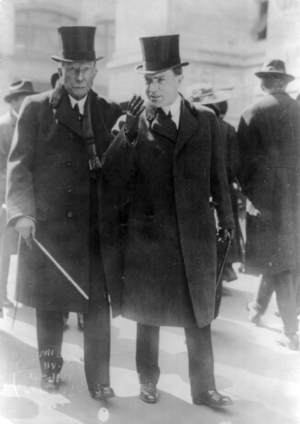
In 1884, Rockefeller provided major funding for Atlanta Baptist Female Seminary in Atlanta for African-American women, which became Spelman College. His wife Laura Spelman Rockefeller, was dedicated to civil rights and equality for women. John and Laura donated money and supported the Atlanta Baptist Female Seminary whose mission was in line with their faith based beliefs. Today known as Spelman College, the school is an all women Historically Black College or University in Atlanta, Georgia, named after Laura's family. The oldest existing building on Spelman's campus, Rockefeller Hall, is named after him. Rockefeller also gave considerable donations to Denison University and other Baptist colleges.

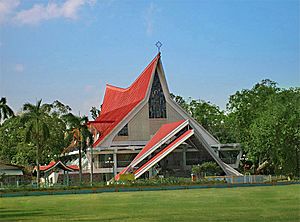
Rockefeller gave $80 million (~$2.17 billion in 2021) to the University of Chicago under William Rainey Harper, turning a small Baptist college into a world-class institution by 1900. He would describe the University of Chicago as "the best investment I ever made." He also gave a grant to the American Baptist Missionaries foreign mission board, the American Baptist Foreign Mission Society in establishing Central Philippine University, the first Baptist and second American university in Asia, in 1905 in the heavily Catholic Philippines.
Rockefeller's General Education Board, founded in 1903, was established to promote education at all levels everywhere in the country. In keeping with the historic missions of the Baptists, it was especially active in supporting black schools in the South. Rockefeller also provided financial support to such established eastern institutions as Yale, Harvard, Columbia, Brown, Bryn Mawr, Wellesley and Vassar. On Gates' advice, Rockefeller became one of the first great benefactors of medical science. In 1901, he founded the Rockefeller Institute for Medical Research in New York City. It changed its name to Rockefeller University in 1965, after expanding its mission to include graduate education. It claims a connection to 23 Nobel laureates. He founded the Rockefeller Sanitary Commission in 1909, an organization that eventually eradicated the hookworm disease, which had long plagued rural areas of the American South. His General Education Board made a dramatic impact by funding the recommendations of the Flexner Report of 1910. The study, an excerpt of which was published in The Atlantic, had been undertaken by the Carnegie Foundation for the Advancement of Teaching.
Rockefeller created the Rockefeller Foundation in 1913 to continue and expand the scope of the work of the Sanitary Commission, which was closed in 1915. He gave $182 million to the foundation, which focused on public health, medical training, and the arts. It endowed Johns Hopkins School of Hygiene and Public Health, the first of its kind. It also built the Peking Union Medical College in China into a notable institution. The foundation helped in World War I war relief, and it employed William Lyon Mackenzie King of Canada to study industrial relations.
In the 1920s, the Rockefeller Foundation funded a hookworm eradication campaign through the International Health Division. This campaign used a combination of politics and science, along with collaboration between healthcare workers and government officials to accomplish its goals.
Rockefeller's fourth main philanthropy, the Laura Spelman Rockefeller Memorial Foundation, was created in 1918. Through this, he supported work in the social studies; this was later absorbed into the Rockefeller Foundation. In total Rockefeller donated about $530 million.
Rockefeller became well known in his later life for the practice of giving dimes to adults and nickels to children wherever he went. He even gave dimes as a playful gesture to wealthy men, such as tire mogul Harvey Firestone.
Rockefeller supported the passage of the 18th Amendment, which banned alcohol in the United States.
Florida home
Henry Morrison Flagler, one of the co-founders of Standard Oil along with Rockefeller, bought the Ormond Hotel in 1890, located in Ormond Beach, Florida, two years after it opened. Flagler expanded it to accommodate 600 guests and the hotel soon became one in a series of Gilded Age hotels catering to passengers aboard Flagler's Florida East Coast Railway. One of Flagler's guests at the Ormond Hotel was his former business partner John D. Rockefeller, who first stayed at the hotel in 1914. Rockefeller liked the Ormond Beach area so much that after four seasons at the hotel, he bought an estate in Ormond Beach called The Casements. It would be Rockefeller's winter home during the latter part of his life. Sold by his heirs in 1939, it was purchased by the city in 1974 and now serves as a cultural center and is the community's best-known historical structure.
Images for kids
-
Rockefeller c. 1902. By then, his moustache had fallen off due to alopecia.
-
Judge Kenesaw Mountain Landis wags his pen at John D. Rockefeller, who is sitting in the witness stand, during the Standard Oil case on July 6, 1907
-
John D. Rockefeller's painting by John Singer Sargent in 1917
See also
 In Spanish: John D. Rockefeller para niños
In Spanish: John D. Rockefeller para niños



